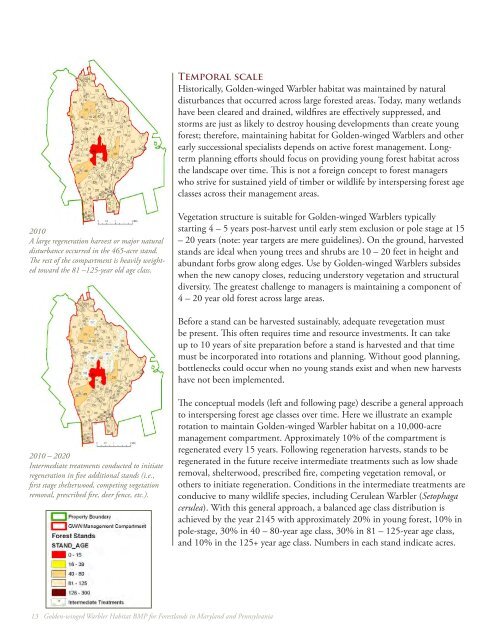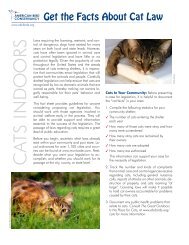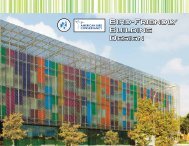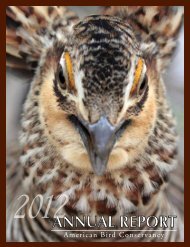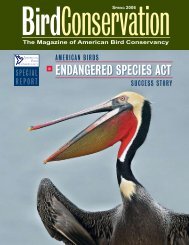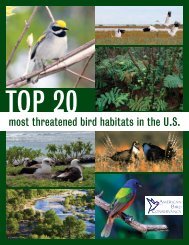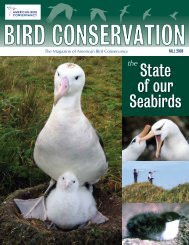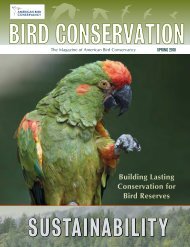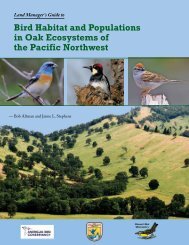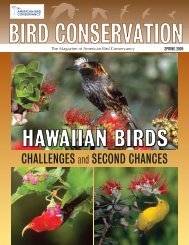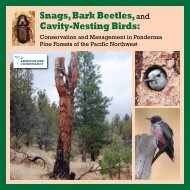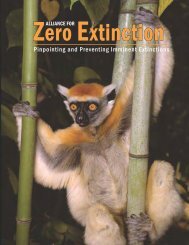GOldEN-wiNGEd WARblER HAbitAt - American Bird Conservancy
GOldEN-wiNGEd WARblER HAbitAt - American Bird Conservancy
GOldEN-wiNGEd WARblER HAbitAt - American Bird Conservancy
Create successful ePaper yourself
Turn your PDF publications into a flip-book with our unique Google optimized e-Paper software.
Temporal scaleHistorically, Golden-winged Warbler habitat was maintained by naturaldisturbances that occurred across large forested areas. Today, many wetlandshave been cleared and drained, wildfires are effectively suppressed, andstorms are just as likely to destroy housing developments than create youngforest; therefore, maintaining habitat for Golden-winged Warblers and otherearly successional specialists depends on active forest management. Longtermplanning efforts should focus on providing young forest habitat acrossthe landscape over time. This is not a foreign concept to forest managerswho strive for sustained yield of timber or wildlife by interspersing forest ageclasses across their management areas.2010A large regeneration harvest or major naturaldisturbance occurred in the 465-acre stand.The rest of the compartment is heavily weightedtoward the 81 –125-year old age class.Vegetation structure is suitable for Golden-winged Warblers typicallystarting 4 – 5 years post-harvest until early stem exclusion or pole stage at 15– 20 years (note: year targets are mere guidelines). On the ground, harvestedstands are ideal when young trees and shrubs are 10 – 20 feet in height andabundant forbs grow along edges. Use by Golden-winged Warblers subsideswhen the new canopy closes, reducing understory vegetation and structuraldiversity. The greatest challenge to managers is maintaining a component of4 – 20 year old forest across large areas.Before a stand can be harvested sustainably, adequate revegetation mustbe present. This often requires time and resource investments. It can takeup to 10 years of site preparation before a stand is harvested and that timemust be incorporated into rotations and planning. Without good planning,bottlenecks could occur when no young stands exist and when new harvestshave not been implemented.2010 – 2020Intermediate treatments conducted to initiateregeneration in five additional stands (i.e.,first stage shelterwood, competing vegetationremoval, prescribed fire, deer fence, etc.).The conceptual models (left and following page) describe a general approachto interspersing forest age classes over time. Here we illustrate an examplerotation to maintain Golden-winged Warbler habitat on a 10,000-acremanagement compartment. Approximately 10% of the compartment isregenerated every 15 years. Following regeneration harvests, stands to beregenerated in the future receive intermediate treatments such as low shaderemoval, shelterwood, prescribed fire, competing vegetation removal, orothers to initiate regeneration. Conditions in the intermediate treatments areconducive to many wildlife species, including Cerulean Warbler (Setophagacerulea). With this general approach, a balanced age class distribution isachieved by the year 2145 with approximately 20% in young forest, 10% inpole-stage, 30% in 40 – 80-year age class, 30% in 81 – 125-year age class,and 10% in the 125+ year age class. Numbers in each stand indicate acres.13 Golden-winged Warbler Habitat BMP for Forestlands in Maryland and Pennsylvania


